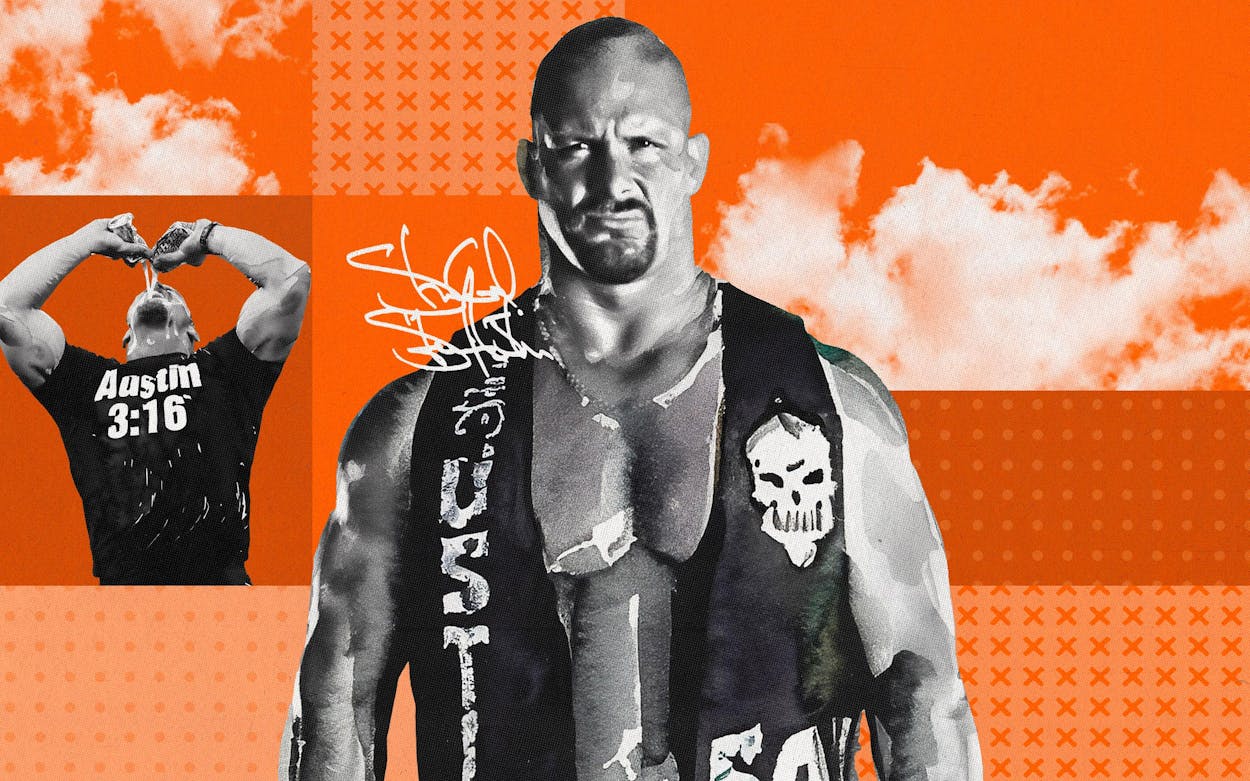The Texas Rattlesnake. The Bionic Redneck. The Bottom Line. Steve Austin has been known by many names, but two words rise above them all to define this true-blue Texan phenomenon: Stone Cold.
The Lone Star State has produced more than its share of pro wrestling icons, but no one has embodied the lawless spirit of the Texas frontier quite like Austin did. And unlike with other WWE superstars who went on to multihyphenate celebrity careers, Austin’s megafame has always stemmed from his work in the squared circle. That is, his singular ability to kick ass, take names, and chug beer.
The mark of a great wrestler isn’t necessarily athleticism, but rather a performer’s ability to reinvent themself and remain relevant over long stretches of time. Contrary to what WWE self-mythologizing might have you believe, Austin was actually an accomplished grappler before he signed with the company. He had been “Stunning” Steve Austin, preening in glittering robes as one of the most dependable heel characters of WWE’s rival promotion, World Championship Wrestling, in the early nineties.
But after Austin was sacked by a changing regime at WCW, he took his career into his own hands, reintroducing himself as a loose cannon raging against wrestling’s powers that be for the independent outfit Extreme Champion Wrestling. The act got him signed with WWE (then the World Wrestling Federation, or WWF), but even there he didn’t immediately find the wrestling persona that would stick with him forever. First he shaved his head and considered a name inspired by an infamous Mafia hit man—“The Iceman.” The perfect moniker still eluded him, though, until his then-wife, Jeanie Clarke, told him one morning that he better drink his cup of tea before it turned “stone cold.” “Stone Cold Steve Austin”—it rolled off his tongue as effortlessly as the straight-shooting, tough-talking, Texan drawl–infused monologues (called promos in wrestling lingo) he delivered on TV.
After defeating Jake “The Snake” Roberts in 1996, Austin cut a scathing promo on Roberts, who had taken to spouting born-again scripture after a lifetime of sinning: “Talk about your Psalms, talk about John 3:16—Austin 3:16 says I just whipped your ass!” Before long, WWF crowds became a sea of black T-shirts with “Austin 3:16” printed in Impact font.
In many ways, the Stone Cold phenomenon owed as much to merchandising and marketing as to Austin’s actual in-ring performances. Like that infamous shirt, Austin’s look was bare-bones: black trunks, black kneepads, and black boots to stomp the hell out of opponents—with a tattoo of the state of Texas and a Longhorn steer peeking out from his calf. But like a rattlesnake, Austin wasn’t the silent predator type. He wanted to grab your attention when he was about to strike.
His star-making moment arrived in 1997, at WrestleMania 13, when he faced “Hitman” Bret Hart in a submission match that served to pass the torch from one face of an era to the next. The bout anointed Austin’s shiny dome with blood: it wasn’t even the main event that day, but in the decades since, few matches on American television have matched its brutality. The wrestlers battered each other with folding chairs and metal crowd barricades and even a bright orange extension cord. Hart and Austin left the ring and fought in the stands, spilling their sweat and blood all over the paying fans.
But Austin’s greatest opponent in the WWE story line was the company itself. He played the antiauthority, blue-collar everyman raging against “the Corporation,” telling off his boss with a frankness that endeared him to millions of fans. Longtime ring announcer Jim Ross described Austin as a “folk hero,” carried to superstardom on the shoulders of the WWE’s audience.
In the years after Austin retired from full-contact wrestling, he did his time as a more family-friendly pop icon: photo shoots with Annie Leibovitz, cameos in Adam Sandler comedies, leading roles in direct-to-video action movies, and even a gig as the host of CMT’s Redneck Island. These days, he tends to stick more to his remote Broken Skull Ranch, about seventy miles south of San Antonio in Tilden. There, he posts updates about his diet and fitness routines and shares adorable pictures of his barn cat.
Even now, less than a year away from his sixtieth birthday, Austin’s badass streak shines through on social media—often in unexpected ways. In January, he posted a travel tip about how to cook a Ziploc bag filled with lima beans and venison in the sink of a hotel bathroom. There is something so irrepressibly Texan about the stubborn insistence on self-reliance that leads one to share details like this: “On this trip I forgot my spoon. Rather than call down to room service and ask for silverware I just use a wine glass as a scoop to get the food out of the bag and drink/eat it. Works as well with a plastic cup. But man, that wine glass was pure luxury.”
Almost two decades after he hung up his boots, Austin laced them up one more time in 2022, at Wrestlemania 38, in Arlington, where Austin fought to defend the honor of his beloved Texas from a pompous French Canadian opponent, Kevin Owens. After driving to the ring in a four-wheeler detailed with Realtree camo, Austin dragged Owens across the LED-lit stage and through the crowd, unleashing years of pent-up aggression with every stomp. Austin’s one-off return was a slugfest, of course, but also a cathartic celebration that allowed fans to crack one last beer with a bona fide legend. More than his killer instincts and steely glare, what got Stone Cold “over”—the wrestling way to say what made him famous—was his quintessentially Texan renegade image, soaked in lukewarm lager and cold blood.
- More About:
- Sports
- Celebrity Bracket
- Victoria






